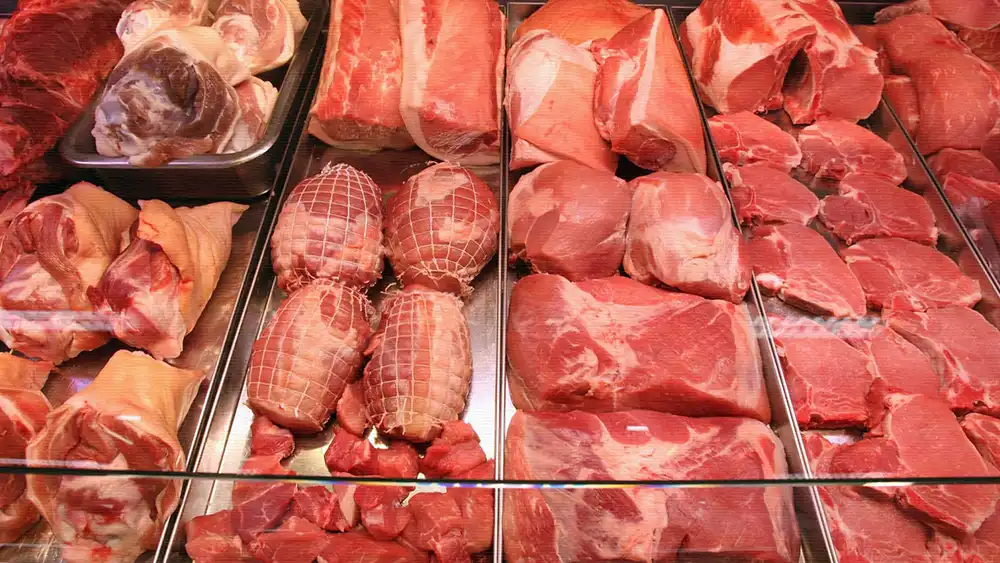
HEALTH BLOG
What is Red Meat and What are Its Health Henefits and Drawbacks?
-
 Rahul Priydarss
Rahul Priydarss - May 17, 2024
Discover the comprehensive guide to red meat, covering its nutritional benefits, potential health risks, and environmental impact. Learn how to incorporate red meat responsibly into your diet while considering sustainability and making informed dietary choices. Unravel myths, explore facts, and strike a balance for optimal health and environmental consciousness.
Introduction of Red Meat:
Red meat refers to the meat from mammals that is red when raw and typically darker in color when cooked. Common examples include beef, lamb, pork, and goat. It is known for its rich flavor and high nutritional value, offering significant amounts of protein, iron, vitamin B12, and zinc. While red meat can be a nutritious part of a balanced diet, its consumption should be moderated due to potential health risks such as heart disease and cancer when consumed in excess or in processed forms. Additionally, the production of red meat has notable environmental impacts, prompting a growing interest in more sustainable dietary choices.
Importance of Red Meat in Diet:
Red meat plays a significant role in many diets worldwide due to its rich nutritional profile and its benefits. It is an excellent source of high-quality protein, essential for building and repairing tissues, producing enzymes and hormones, and supporting overall growth and development. Additionally, red meat provides heme iron, which is more easily absorbed by the body compared to non-heme iron found in plant-based foods. Iron is crucial for forming hemoglobin in red blood cells, which transports oxygen throughout the body.
Another key nutrient in red meat is vitamin B12, one of the best natural sources available. Vitamin B12 is necessary for nerve function, DNA synthesis, and the production of red blood cells. Red meat also offers significant amounts of zinc, which is essential for immune function, wound healing, DNA synthesis, and cell division. Furthermore, red meat provides other important nutrients like phosphorus, niacin, and selenium, all of which contribute to various bodily functions.

Table of Contents
The health benefits of red meat are noteworthy. Its high protein content helps in maintaining muscle mass and strength, particularly important for athletes, older adults, and those recovering from illness or injury. The iron in red meat helps prevent iron deficiency anemia, a condition that can cause fatigue and weakness, thereby supporting sustained energy levels and overall vitality. Additionally, vitamin B12 is vital for brain health, and a deficiency in this nutrient can lead to cognitive issues and neurological disorders. Regular consumption of red meat can help maintain adequate B12 levels, contributing to better cognitive function.
Nutritional Profile of Red Meat:
Red meat is renowned for its rich nutritional profile, offering a variety of essential nutrients that contribute significantly to overall health. Here is an overview of the key components found in red meat.
Protein: Red meat is an excellent source of high-quality protein, containing all the essential amino acids needed for the body’s functions. Protein is crucial for building and repairing tissues, including muscles, skin, and organs. It also plays a vital role in producing enzymes, hormones, and other important body chemicals.
Iron: One of the standout features of red meat is its high iron content, specifically heme iron. Heme iron is more easily absorbed by the body compared to non-heme iron found in plant-based foods. Iron is essential for forming hemoglobin, the protein in red blood cells that transports oxygen from the lungs to the rest of the body. Adequate iron intake helps prevent iron deficiency anemia, which can cause fatigue and weakened immune function.
Vitamin B12: Red meat is one of the best dietary sources of vitamin B12, a vital nutrient for nerve health, DNA synthesis, and the production of red blood cells. A deficiency in vitamin B12 can lead to neurological issues and anemia, underscoring the importance of this vitamin in the diet.
Zinc: Zinc is another important mineral found in red meat. It supports numerous biological functions, including immune response, cell division, and wound healing. Zinc is also necessary for proper growth and development, making it particularly important for children and pregnant women.
Other Nutrients: Red meat also contains a range of other essential nutrients, including.
- Phosphorus: Important for the formation of bones and teeth, as well as for the body’s energy production processes.
- Niacin (Vitamin B3): Supports digestive health, skin health, and nerve function. It also helps convert food into energy.
- Selenium: Acts as an antioxidant, protecting cells from damage and supporting thyroid function.
- Creatine: Plays a role in energy production, particularly in muscles, and can enhance physical performance and strength.
Fat Content: Red meat contains varying levels of fat, including both saturated and unsaturated fats. While fat is a necessary part of the diet, providing energy and supporting cell function, it’s important to choose lean cuts of red meat to limit the intake of saturated fats, which can contribute to heart disease if consumed in excess.
Calories: The calorie content of red meat varies depending on the cut and preparation method. Generally, red meat is calorie-dense, which can be beneficial for individuals needing more energy but requires mindful consumption to avoid excessive calorie intake and potential weight gain.
Health Benefits of Red Meat:
Red meat, when consumed in moderation and as part of a balanced diet, offers several health benefits due to its rich nutrient profile. Here are some of the key health benefits associated with red meat.
High-Quality Protein Source: Red meat is a rich source of high-quality protein, which is essential for the growth, repair, and maintenance of body tissues. Protein is also crucial for the production of enzymes and hormones, and it plays a key role in muscle development and overall physical health. For athletes, bodybuilders, and those recovering from illness or surgery, the protein in red meat can support muscle repair and growth.
Iron Content: Red meat provides a substantial amount of heme iron, which is more easily absorbed by the body compared to the non-heme iron found in plant foods. Iron is vital for the production of hemoglobin, the component of red blood cells that carries oxygen throughout the body. Adequate iron intake helps prevent iron-deficiency anemia, characterized by fatigue, weakness, and compromised immune function.
Vitamin B12: Red meat is one of the best dietary sources of vitamin B12, a nutrient critical for nerve health, DNA synthesis, and the production of red blood cells. A sufficient intake of vitamin B12 can help prevent neurological issues and certain types of anemia. Regular consumption of red meat ensures that the body maintains adequate levels of this vital vitamin, supporting overall brain health and cognitive function.
Zinc: Zinc is an essential mineral found abundantly in red meat. It plays a crucial role in immune function, wound healing, DNA synthesis, and cell division. Zinc is also important for proper growth and development, making red meat a valuable food source for children, teenagers, and pregnant women. A diet that includes red meat can help maintain optimal zinc levels, supporting a strong immune system and overall health.
Other Essential Nutrients: Red meat also provides other essential nutrients, such as phosphorus, niacin (vitamin B3), and selenium. Phosphorus is important for healthy bones and teeth, as well as for the body’s energy production processes. Niacin supports digestive health, skin health, and nerve function, while selenium acts as an antioxidant, protecting cells from damage and supporting thyroid function.
Muscle Mass and Physical Performance: The creatine found in red meat plays a role in energy production, particularly in muscle cells. It can enhance physical performance, strength, and muscle mass, making it beneficial for athletes and those engaged in regular physical activity. The presence of creatine in red meat can help improve overall muscle function and endurance.
Mental Health and Cognitive Function: The B vitamins, particularly vitamin B12, found in red meat are essential for brain health. These vitamins support the proper functioning of the nervous system and can help prevent cognitive decline and mood disorders. Including red meat in the diet can contribute to better mental health and cognitive performance.
Energy Levels: The combination of protein, iron, and other nutrients in red meat helps maintain stable energy levels throughout the day. Protein provides a sustained source of energy, while iron ensures that oxygen is efficiently transported to cells, supporting overall energy production and reducing feelings of fatigue.

Potential Health Risks with Red Meat:
While red meat offers various nutritional benefits, its consumption has also been associated with potential health risks when consumed excessively or in certain forms. Here are some of the main health concerns linked to red meat.
Increased Risk of Heart Disease: Red meat, especially when consumed in large quantities and in processed forms like bacon, sausage, and deli meats, is often high in saturated fats and cholesterol. These components can contribute to elevated levels of LDL (bad) cholesterol in the blood, increasing the risk of heart disease, stroke, and other cardiovascular issues.
Higher Cancer Risk: Several studies have suggested a link between high consumption of red meat, particularly processed meats, and an increased risk of certain types of cancer, notably colorectal cancer. The mechanisms behind this association are not entirely clear, but it is thought that compounds formed during the cooking or processing of meat, such as heterocyclic amines (HCAs) and polycyclic aromatic hydrocarbons (PAHs), may play a role in carcinogenesis.
Potential for Weight Gain and Obesity: Red meat is often calorie-dense, and excessive consumption can contribute to weight gain and obesity, especially when coupled with a sedentary lifestyle and a diet high in processed foods and added sugars. Obesity is a significant risk factor for numerous health conditions, including heart disease, type 2 diabetes, and certain cancers.
Digestive Issues: Some individuals may experience digestive discomfort, such as bloating, gas, or constipation, when consuming large amounts of red meat, particularly fatty cuts or processed varieties. Additionally, certain compounds found in red meat, such as heme iron and sulfurous amino acids, may contribute to the production of potentially harmful substances in the gut, which could exacerbate digestive issues or increase the risk of gastrointestinal disorders.
Environmental Impact: The production of red meat, particularly beef, has significant environmental implications, including greenhouse gas emissions, deforestation, water pollution, and habitat destruction. Large-scale livestock farming requires vast amounts of land, water, and feed resources, contributing to environmental degradation and climate change. As such, excessive consumption of red meat can indirectly impact human health through its environmental footprint.
Antibiotic Resistance: In intensive animal farming practices, antibiotics are often used to promote growth and prevent disease in livestock. However, the overuse and misuse of antibiotics in agriculture can contribute to the development of antibiotic-resistant bacteria, posing a risk to human health by reducing the effectiveness of antibiotics in treating infections.
Red Meat vs. Other Protein Sources:
When comparing red meat to other protein sources, several factors come into play, including nutritional content, health considerations, environmental impact, and culinary versatility. Here’s a comparison between red meat and other common protein sources.
Nutritional Content: Red meat, such as beef, pork, lamb, and goat, is rich in high-quality protein, iron (particularly heme iron), vitamin B12, zinc, and other essential nutrients. However, it can also be higher in saturated fats and cholesterol compared to some other protein sources.
Other protein sources like poultry (chicken, turkey), fish, eggs, dairy products, legumes (beans, lentils, chickpeas), nuts, seeds, and tofu offer varying nutrient profiles. Poultry and fish are typically lower in saturated fats and cholesterol compared to red meat but still provide ample protein, vitamins, and minerals. Plant-based protein sources like legumes, nuts, seeds, and tofu are generally lower in saturated fats and cholesterol, higher in fiber, and often rich in vitamins, minerals, and antioxidants.
Health Considerations: Red meat consumption has been associated with an increased risk of heart disease, certain cancers (especially processed meats), and other health issues when consumed excessively. Choosing lean cuts of red meat and limiting intake of processed varieties can help mitigate these risks. In contrast, poultry, fish, and plant-based protein sources are generally considered healthier options due to their lower saturated fat content and potential health benefits, such as reducing the risk of chronic diseases like heart disease and certain cancers.
Environmental Impact: The production of red meat, particularly beef, has a significant environmental footprint, including greenhouse gas emissions, land and water use, and deforestation. Poultry and fish generally have a lower environmental impact compared to red meat, although intensive farming practices can still raise concerns about pollution, habitat destruction, and overfishing. Plant-based protein sources, such as legumes, nuts, seeds, and tofu, tend to have the lowest environmental impact, requiring fewer resources and producing fewer greenhouse gas emissions compared to animal-based proteins.
Culinary Versatility: Red meat is highly versatile in cooking and is commonly used in a wide range of dishes, from grilled steaks to hearty stews. Poultry, fish, eggs, dairy products, and plant-based protein sources also offer versatility in the kitchen and can be used in various cuisines and cooking styles. Plant-based protein sources, in particular, lend themselves well to creative cooking techniques and can be incorporated into vegetarian and vegan dishes for those with dietary preferences or restrictions.
Myths About Eating Red Meat:
Despite its nutritional benefits, red meat has been the subject of various myths and misconceptions. Here are some common myths about red meat debunked.
Myth 1: Red Meat is Always Unhealthy: While excessive consumption of red meat, especially processed varieties, has been linked to certain health risks, moderate consumption of lean cuts can be part of a healthy diet. Red meat provides essential nutrients like protein, iron, vitamin B12, and zinc, which are important for overall health and well-being.
Myth 2: Red Meat Causes Heart Disease: While red meat is often associated with heart disease due to its saturated fat and cholesterol content, research suggests that the relationship may not be as straightforward as once thought. Consuming lean cuts of red meat in moderation, along with a balanced diet rich in fruits, vegetables, whole grains, and healthy fats, can be compatible with heart health.
Myth 3: Red Meat is the Only Source of Protein: While red meat is a significant source of protein, it is not the only option available. Poultry, fish, eggs, dairy products, legumes, nuts, seeds, and tofu are all excellent sources of protein and offer various health benefits. Including a variety of protein sources in your diet ensures that you get a wide range of nutrients.
Myth 4: Red Meat is Always Bad for the Environment: While the production of red meat, especially beef, can have a significant environmental impact, not all red meat is equally detrimental. Sustainable farming practices, such as rotational grazing and regenerative agriculture, can minimize the environmental footprint of red meat production. Additionally, other protein sources, such as poultry, fish, and plant-based options, also have environmental considerations.
Myth 5: Red Meat Causes Cancer: While some studies have suggested a link between high consumption of processed red meat and certain types of cancer, the evidence is not conclusive. Consuming lean cuts of red meat in moderation, along with a balanced diet rich in fruits, vegetables, and whole grains, can reduce the risk of cancer. Additionally, cooking red meat at lower temperatures and avoiding charring or overcooking can help mitigate potential risks.
Myth 6: Red Meat is Difficult to Digest: While red meat can be higher in fat and protein compared to some other foods, it is not inherently difficult to digest for most people. However, individuals with certain digestive conditions, such as irritable bowel syndrome (IBS) or inflammatory bowel disease (IBD), may find that red meat exacerbates symptoms. Choosing lean cuts and cooking red meat using gentle methods, such as grilling or roasting, can make it easier to digest.
FAQs about Red Meat:
A1: Red meat can be part of a healthy diet in moderation, offering essential nutrients like protein, iron, and vitamin B12. However, excessive consumption, especially of processed types, may pose health risks.
A2: Red meat is rich in protein, iron (heme), vitamin B12, and zinc, supporting various bodily functions such as tissue repair, oxygen transport, and immune health.
A3: It’s recommended to limit red meat intake to 1-2 servings (3-4 ounces each) per week, opting for lean cuts to balance nutritional benefits with potential health risks.
A4: Yes, red meat production contributes to environmental issues like greenhouse gas emissions and deforestation. Sustainable farming practices and reducing consumption can help mitigate these impacts.
A5: Misconceptions include beliefs that red meat is always unhealthy, causes heart disease or cancer, and is the sole protein source. Moderate intake and evidence-based information are essential for informed dietary choices.

-Please remember, to always consult with healthcare professionals or Doctors for personalised advice related to medical conditions.
Conclusion:
In summary, red meat offers valuable nutrients but should be consumed in moderation to avoid health risks like heart disease and cancer. Considering its environmental impact, diversifying protein sources with options like poultry, fish, and plant-based foods is prudent for overall health and sustainability. Clarifying misconceptions about red meat is crucial for making informed dietary choices.




